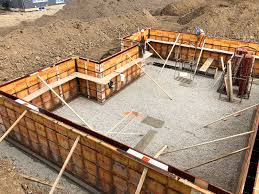Temporary concrete forms should be left to support the concrete until the concrete has thoroughly dried and reached an ideal strength to support its shape. This usually takes about two days after pouring the concrete.
If you remove the formwork too soon, the concrete might begin to sag, crack, and collapse. Remember to be patient and let your concrete thoroughly dry before removing formwork.
The type of formwork you use will depend on your project needs. A simple temporary plywood formwork, such as plank shuttering, is suitable for moulding concrete paths and driveways.
But if you’re building a concrete midrise formwork foundation for a home, you will want to use more sophisticated formwork, such as permanent insulated concrete forms.
WHAT ARE INSULATED CONCRETE FORMS (ICF)?
Unlike traditional concrete forms, insulating concrete forms (ICF) are not removed once the concrete hardens. Instead, ICFs remain as permanent parts of the concrete structure.
While concrete creates the structure, the ICFs insulate the structure. Homes and buildings with ICF foundations are soundproof, airtight, and comfortable in all seasons. This insulation helps homeowners save on energy costs for heating and cooling throughout the year.
ICFs are often made from a combination of insulating materials, such as plastic foam beads and cement, or wood fibre and cement.
Another popular material for ICFs is expanded or extruded polystyrene. Expanded polystyrene is made by expanding plastic beads in a mould, similar to Styrofoam coffee cups.
Extruded polystyrene is made by expanding plastic resin and extruding through a die, similar to meat trays from grocery stores.
ICFs typically come in blocks or planks. ICF block systems are pre-formed with foam and metal or plastic ties. They are ready to stack and interlock when they arrive on site.
Plank ICFs are individual panels or planks of foam requiring assembly on site with ties.
Block ICFs save you time and labour costs, while plank ICFs save on shipping costs since they are more compact to ship.
These concrete forms usually provide at least two inches of insulation on both sides of a concrete wall.
ICFs are not only faster to place, but they also provide significantly better insulation compared to wood or steel frames. So if you’re planning to build a new home, consider using ICFs for a well-insulated foundation.






